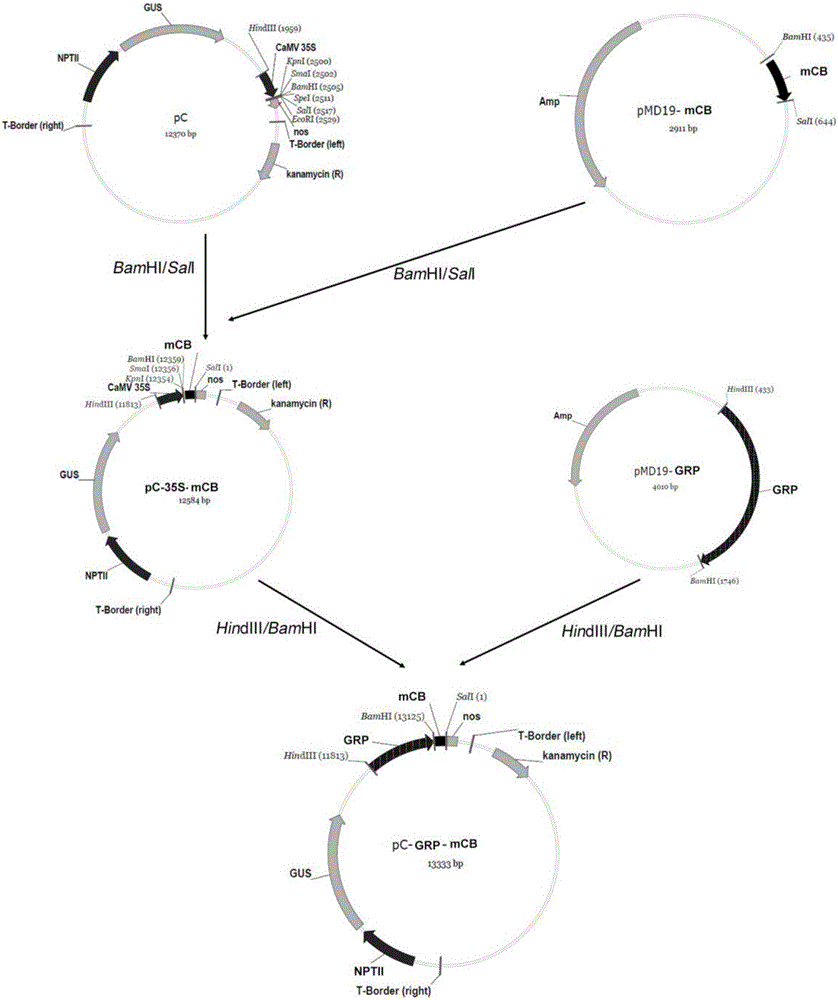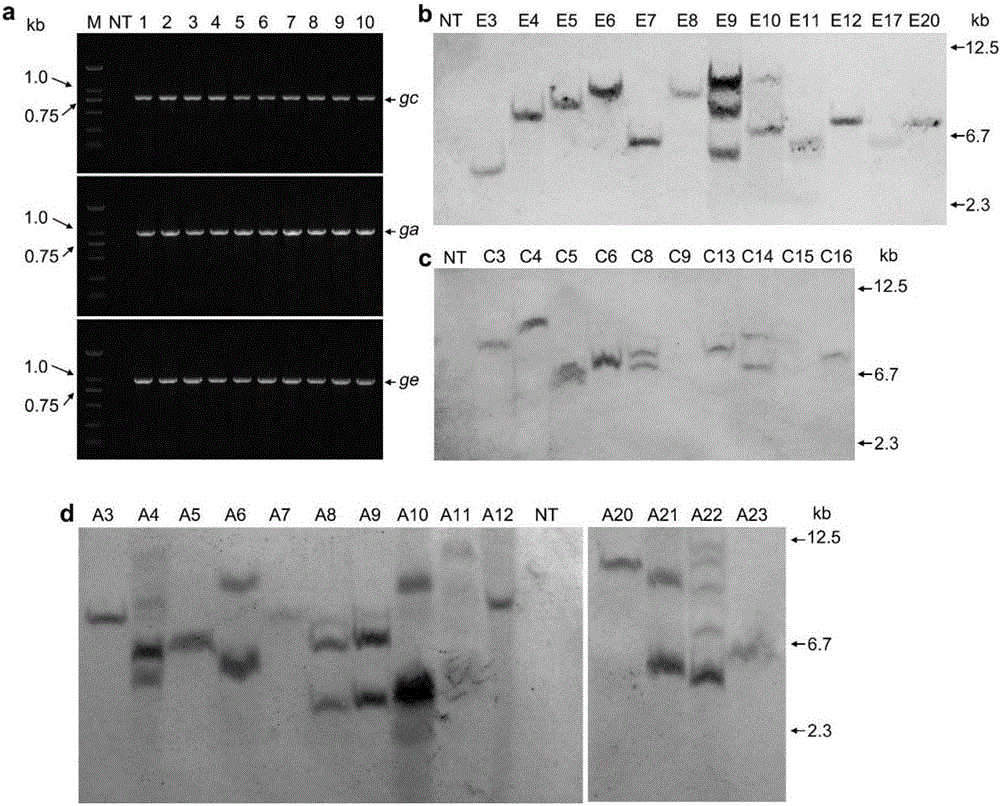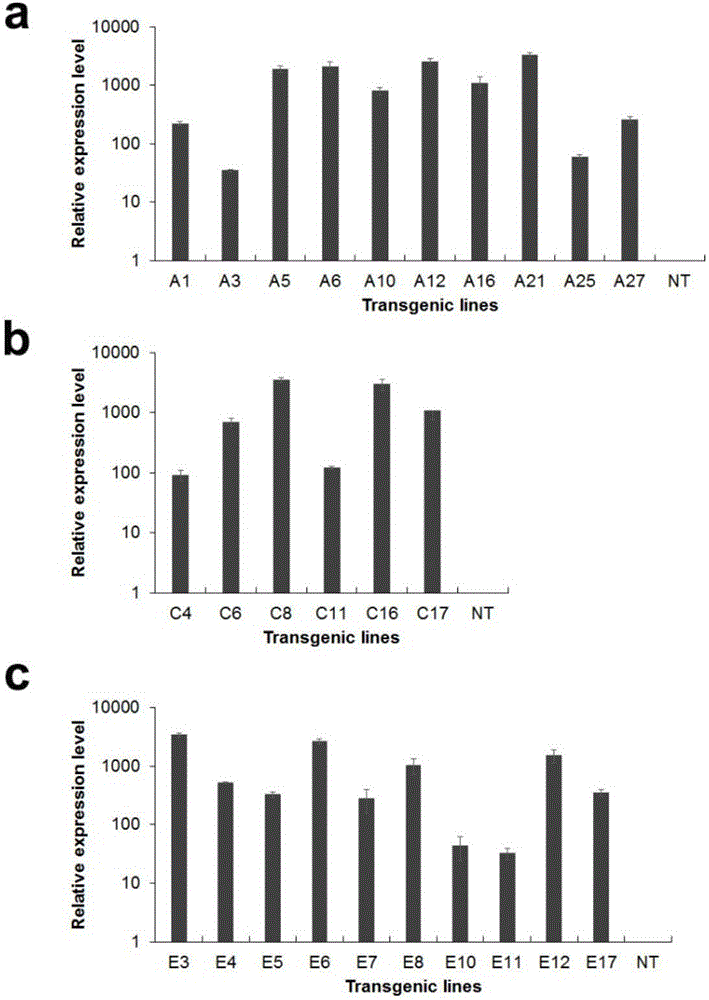Method for improving citrus huanglongbing resistance
A technology for citrus huanglongbing and disease resistance, which is applied in the field of molecular biology, can solve the problems of the antibacterial peptide gene huanglongbing resistance mechanism and the strength is unclear, and no new citrus huanglongbing resistance has been obtained, so as to improve the Disease resistance and yield in citrus, and the effect of enhancing resistance levels
- Summary
- Abstract
- Description
- Claims
- Application Information
AI Technical Summary
Problems solved by technology
Method used
Image
Examples
Embodiment 1
[0028] Embodiment 1 Method introduction
[0029] 1. Extraction of DNA
[0030] Select 0.1-1 g of citrus veins, use Aidlab company kit (cat.No.DN15) to extract genomic DNA, and store at -20°C for later use.
[0031] 2. RNA extraction and cDNA synthesis
[0032] Select 0.1 g of citrus leaf veins and use the EASYspin Plant RNA Rapid Extraction Kit (Aidlab, cat. No. RN09) to extract total RNA from leaves, and use non-denaturing agarose gel electrophoresis and UV spectrophotometer scanning to detect the quality of RNA. cDNA first-strand synthesis according to BIO-RAD iScript TMcDNA Synthesis Kit (BIO-RAD, cat. No. 170-8891) instructions. The synthesized cDNA was stored at -20 for future use.
[0033] 3. PCR Amplification of Genomic Sequence
[0034] 10 Ex PCR buffer (Mg 2+ free) 2.5μL, 2.5mmol / L dNTPs 2μL, 25mmol / L MgCl 2 2 μL, primer 1 (5 μmol / L) 1 μL, primer 2 (5 μmol / L) 1 μL, Ex Taq DNA polymerase 1U, genomic DNA about 60ng, add ddH 2 0 to 25 μL. The amplification prog...
Embodiment 2
[0039] Example 2 Vector construction
[0040] 1. Acquisition of a specific promoter
[0041] According to the cowpea phloem-specific promoter GRP (GenBank accession number: AF250148.1), primers (GRP-f and GRP-r, see Table 5) were designed, and a fragment of about 600 bp was obtained by PCR amplification from the cowpea genome. The sequence analysis after cloning the amplified DNA fragment shows that it is the GRP specific promoter of cowpea, see SEQ ID No.4.
[0042] The primer sequence used in the embodiment of table 5
[0043]
[0044]
[0045] 2. Synthesis of antimicrobial peptide gene spCB
[0046] According to the cecropin gene Cecropin B sequence, there are secreted antibacterial peptide genes CB, PR1aCB and PR1aCBer artificially synthesized by Shanghai Bioengineering Co., Ltd. The ATG at the 5' end of PR1aCB and PR1aCBer contains the signal peptide sequence PR1a from the tobacco PR1a gene, and the plant translation enhancer sequence AAGGAGAUAUAACA is added upst...
Embodiment 3
[0050] Example 3 Genetic Transformation
[0051] 1. Introduce the constructed plant expression vector plasmid into Agrobacterium EHA105 by electric shock method.
[0052] Referring to the Bio-RAD MicroPulser user manual, the above-mentioned vectors GRP::CB, GRP::PRlaCB and GRP::PRlaCBer were introduced into Agrobacterium EHA105 by electric shock transformation method.
[0053] 2. The vector specifically expressing the antimicrobial peptide gene was integrated into the citrus genome
[0054] The genetic transformation of citrus was carried out by the method mediated by Agrobacterium tumefaciens, and the medium used is shown in Table 1.
[0055] Table 1 Medium for genetic transformation of citrus mediated by Agrobacterium tumefaciens
[0056]
[0057]
[0058] MS: Murashige & Skoog medium (Murashige & Skoog, 1962); Gelrite: plant gel (Sigma, product number: G1910); BA: 6-benzylaminopurine; IAA; 3-indoleacetic acid; 2,4-D: 2,4- Dichlorophenoxyacetic acid; Cef: cephalospo...
PUM
 Login to View More
Login to View More Abstract
Description
Claims
Application Information
 Login to View More
Login to View More - R&D
- Intellectual Property
- Life Sciences
- Materials
- Tech Scout
- Unparalleled Data Quality
- Higher Quality Content
- 60% Fewer Hallucinations
Browse by: Latest US Patents, China's latest patents, Technical Efficacy Thesaurus, Application Domain, Technology Topic, Popular Technical Reports.
© 2025 PatSnap. All rights reserved.Legal|Privacy policy|Modern Slavery Act Transparency Statement|Sitemap|About US| Contact US: help@patsnap.com



